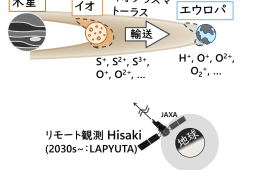PPARCセミナー (2025/06/16)

PPARCセミナー (2025/06/16)
(1)
[Name]
Ayuto Kawakami
[Title]
ボイジャー2号の観測データを用いた天王星・海王星電波の解析
[Abstract]
1977年8月にNASAにより打ち上げられたボイジャー2号は、1986年に天王星、1989年に海王星に接近しており、現在氷惑星を訪れた唯一の探査機である。そのボイジャー2号が天王星や海王星を一度フライバイした際の、1.2kHzから40MHzの電波を観測するPRA(Planetary Radio Astronomy)データをpythonにおけるMASERを使用し解析した。これを図示することで、天王星におけるUKR(Uranian Kilometric Radiation)の構造や円偏波の特徴を導いた。また、ボイジャー2号が観測したデータそのものには一定周期の強いパルス形のノイズが加わっており、さらに特定の周波数帯において断続的に強いノイズが加わっていたため、惑星電波の特徴が一目では見にくく、時系列ごとの強度を考えるには扱いづらい形になっていた。そこで、UKRに必要のない周波数帯を除き、移動平均や移動中央値をとることでノイズをある程度除去した。しかし、Lamy+(2023)における天王星の惑星電波の図が再現できず、どのように作られているのか不明瞭であった。一方、SPICEを使用して天王星フライバイ前後のボイジャー2号の位置情報を取得し、UKRの強度を距離により補正することを試みた。UKRを用いた天王星衛星の内部構造の探査の可否が議論されているなど、活用する方法が現在考えられており、ボイジャー2号のデータを解析することは、次なる氷惑星への探査計画を立案することへの大きな意義を持っていると思われる。
(2)
[Name]
Natsuko Matsushita
[Title]
イオプラズマトーラスの輸送 ~動径拡散モデルの先行研究紹介~
Radial transportation of the Io plasma torus: paper introduction of radial diffusion model
[Abstract]
木星内部磁気圏プラズマの半径方向分布は、Voyager 1号・2号、Cassini の観測に基づいて Delamere ほか(2005)によって調べられてきた。この研究では、カッシーニ時代のプラズマ動径方向分布を再現するには、中性粒子源の速度が700-1200kg/s、輸送時間が100-200日 (L = 6~9)であることを示した。また、コア電子温度を決定する主要因が、空間的・時間的に変化するホットな電子であることを見出した。
PPARCを2020年度に修了した山口さんは、修士論文で、時間依存する動径方向拡散モデルを構築し、定常時のプラズマ状態とプラズマ分布の時間変化をひさき/EXCEEDの観測結果と比較した。その結果、イオプラズマトーラスの発光強度が高まった2015年に観測されたプラズマ分布の時間変化は、中性粒子源の増加と熱い電子密度の変化を両方とも導入することで再現された。質量の流れについては、電荷交換と再結合による中和が最も支配的な損失過程であった。エネルギーの流れに関しては、生成過程の70%がホット電子による加熱からもたらされ、損失過程の80%がUV放射であった。
自身の研究では今後、木星磁気圏の動径方向輸送モデルを用いて、ひさき観測のエウロパ軌道まで含んだ結果を再現しようと計画している。そこで今回のセミナーでは、これらの先行研究を紹介する。
The radial distribution of the Jovian inner magnetospheric plasma has been examined based on observations of Voyager 1, 2 and Cassini spacecraft by Delamere et al. (2005). They found that radial variations during the Cassini era were consistent with a neutral source rate of 700–1200 kg/s, an integrated transport time from L = 6 to 9 of 100–200 days, and that the core electron temperature was largely determined by a spatially and temporally varying hot electron population.
Yamaguchi et al., in his master’s thesis, developed a time-dependent radial diffusion model and compared the plasma conditions during steady state and time variations of plasma distribution with the HISAKI/EXCEED observation. They found that observed time variations of Io plasma torus in 2015, when its emission was enhanced, was reproduced by introducing both increase of neutral source rate and variation of the hot electron density. For the mass flow, neutralization by charge exchange and recombination was the most dominant loss process. As for the energy flow, the 70 % of source process was provided from thermal electron heating by hot electrons, and 80% of loss process was the UV radiation.
In this seminar, I will introduce these previous studies because I will use the radial transportation model of Jovian magnetosphere to reproduce the HISAKI observation including Europa’s orbit.





